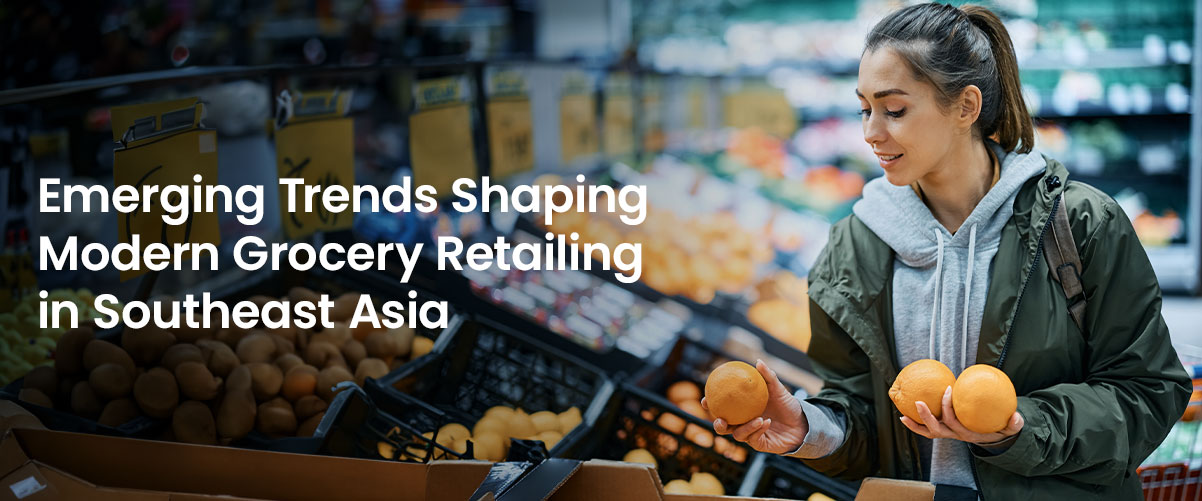Introduction
In the dynamic landscape of Southeast Asian grocery retailing, several emerging trends are shaping the industry and influencing the way consumers shop for their daily needs. These trends reflect changing consumer priorities, the evolving competitive environment, and the industry’s collective push for profitability, sustainability, and enhanced customer experiences. Here, we delve into these six critical trends that are redefining modern grocery retailing in Southeast Asia:
The ASEAN region offers substantial growth prospects for contemporary grocery retailers. With a population exceeding 600 million, yearly grocery expenditures reach $200 billion. Traditional trade still dominates, accounting for roughly two-thirds of these expenses, signifying untapped potential for the modern grocery sector to gain a larger market share. Anticipated overall consumer spending across ASEAN is projected to increase by approximately 5% in the coming year, contingent on global economic influences. Urban consumers, in particular, demonstrate a growing demand, transitioning their spending habits from fragmented to modern shopping channels. This shift is propelling significant growth in modern retail, with our analysis forecasting annual expansion rates of 6 to 7% until 2025. As a result, ASEAN stands out as one of the world’s swiftest-growing and most promising regions for contemporary grocers. (see image below)
The penetration of modern retail tends to follow growth in GDP per capita, with wide variations across Southeast Asia.
1 Retail sales value, including sales tax.
2 The Log10 (or common logarithm) is used to simplify the scale for countries with large differences in GDP per capita. For example, log10 of 3 is 1,000; log10 of 4 is 10,000; and log10 of 5 is 10,000.
Source: Euromonitor
1. Priorities Influencing Consumer Purchasing Decisions
In the fast-paced world of grocery retailing, consumers are influenced by several key priorities. These include:
- Consumers are becoming more value-conscious. They seek quality products at reasonable prices. Grocery retailers that offer competitive pricing, promotions, and loyalty programs are gaining a competitive edge.
- Healthy Nutrition: There’s a growing awareness of the importance of healthy eating. Consumers are looking for fresh, organic, and locally-sourced products. Retailers are responding by expanding their offerings of fresh and nutritious products.
- Willingness to Purchase Food Online: The convenience of online grocery shopping has gained popularity. Retailers are investing in robust e-commerce platforms, ensuring a seamless online shopping experience.
2. Fierce Competition from Ecosystem Players
The grocery retail sector in Southeast Asia faces fierce competition from ecosystem players, including digital giants and online marketplaces. These competitors have an advantage in terms of data on consumer behaviour and can attract and retain consumers by creating exceptional shopping experiences. The pressure on traditional fresh food offerings is particularly palpable as digital players expand their influence. Grocery retailers are responding by leveraging data-driven insights and investing in technologies that enhance the consumer experience. Solutions like ETP V5 are pivotal in staying competitive and relevant in this ecosystem.
Table 1: Advantages of Ecosystem Players in Grocery Retail
| Advantages | Impact on Grocery Retailers |
|---|---|
| Data on Consumer Behaviour | Informed decision-making for targeted offerings |
| Creating Exceptional Customer Experiences | Enhanced customer loyalty and satisfaction |
| Pressuring Fresh Offerings | Traditional grocery retailers innovate and compete more effectively |
3. A Shift from Growth to Profitability
While grocery retailers have made impressive progress towards growth, breaking even and achieving profitability still remains a challenge. Grocery retailers are re-evaluating their strategies to find new sources of profitability. By embracing technology solutions like ETP V5, retailers can streamline operations, improve inventory management, and optimize the supply chain, leading to reduced costs and improved profitability. The shift from growth-focused expansion to a profit-centric approach is becoming imperative for long-term sustainability.
4. Reframe Your Playing Field to Embrace Consumer Tech
To stay relevant, grocery retailers are adopting a consumer tech mindset. This approach involves converging into a “consumer tech” ecosystem and thinking like disruptors. It empowers them to focus on providing the best consumer experiences, from seamless online shopping to in-store innovation. By embracing technology, grocery retailers can enhance customer interactions, boost loyalty, and reimagine their roles in the lives of consumers.
5. Competing Demands on Omni-channel
Omni-channel retailing is no longer a novelty but a necessity in the grocery sector. The surge in e-commerce penetration has increased the gross merchandise value and amplified user acquisition and retention. Retailers are navigating the competing demands of this complex ecosystem by optimizing their online and offline channels, offering a convenient and consistent shopping experience to consumers regardless of their preferred platform.
Table 2: The Impact of E-commerce on Grocery Retail
| E-commerce Impact | Response from Grocery Retailers |
|---|---|
| Increased Gross Merchandise Value (GMV) | Expanding online product offerings |
| Growing User Acquisition and Retention | Enhancing customer loyalty programs |
6. A Growing Emphasis on Sustainability
Sustainability is a significant theme in the grocery retailing landscape of Southeast Asia. Retailers are not only focusing on profit but also on pursuing profitable, sustainable, and inclusive growth. This includes initiatives to reduce food waste, source products responsibly, and decrease the environmental footprint of operations. Consumers are increasingly considering the social and environmental responsibility of retailers when making purchasing decisions, and businesses that align with these values are poised for success.
Wrapping up, the grocery retail landscape in Southeast Asia is rapidly evolving, driven by consumer preferences and technological advancements. Grocery retail is adapting to meet the changing consumer landscape and leveraging technology to enhance its operations, all while placing an increasing emphasis on sustainability and the consumer experience. By embracing these trends, grocery retailers can stay competitive, achieve profitability, and provide an innovative and sustainable shopping experience for their customers. With the right strategies and retail technology solutions like ETP V5, they can successfully secure their position in the modern grocery retailing landscape of Southeast Asia.
To know more about the business benefits that ETP V5 omni-channel retail software offers the grocery retail segment, visit https://www.etpgroup.com/industries/grocery/ or write to contactus@etpgroup.com



